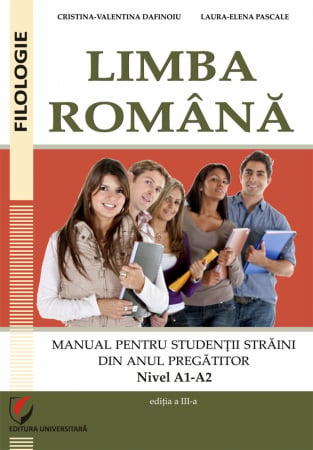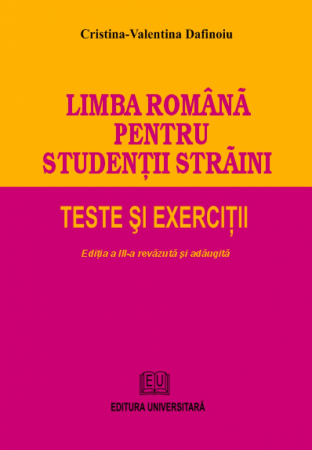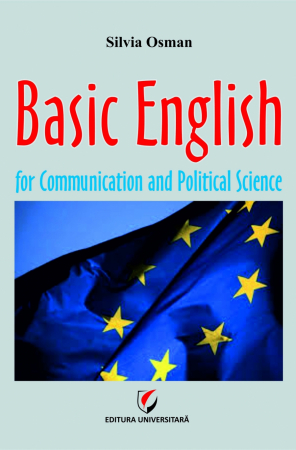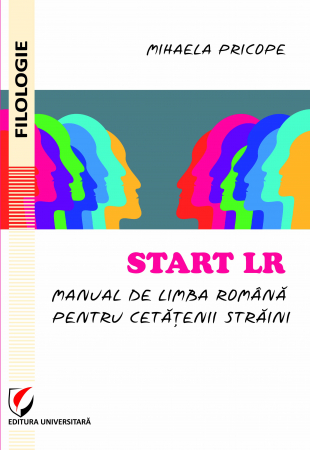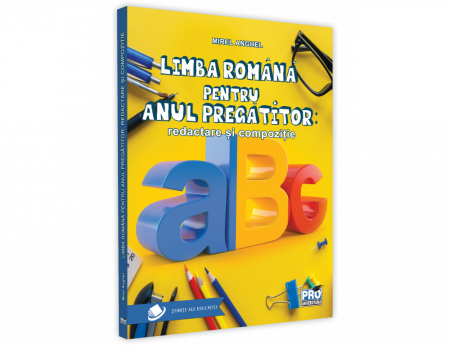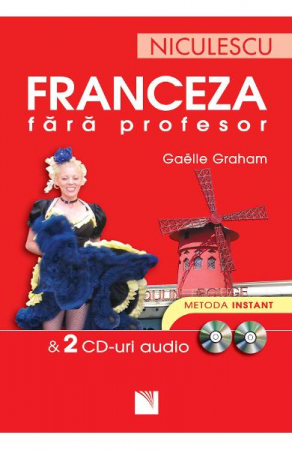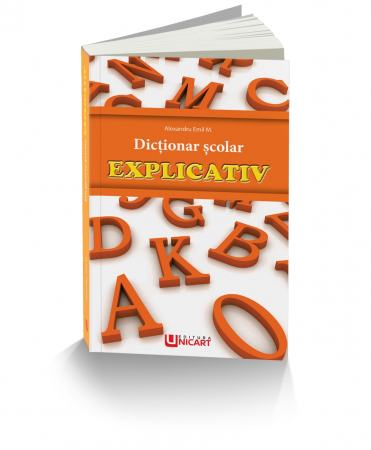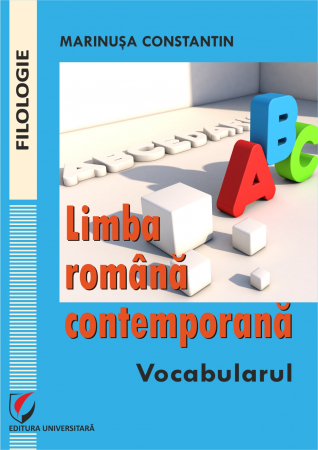Manuscript proposals: info@editurauniversitara.ro / 0745 204 115 //// Tracking orders Individuals / Sales:0745 200 718 / 0745 200 357 Orders Legal entities: 0721 722 783
ISBN: 978-606-28-1334-5
DOI: https://doi.org/10.5682/9786062813345
Publisher year: 2021
Edition: I
Pages: 122
Publisher: Editura Universitara
Author: Simona Palasca
Product Code:
9786062813345
Do you need help?
0745 200 718
/
0745 200 357
- Description
- Download (1)
- Authors
- Content
- More details
- Where to find it
- Reviews (0)
Two fundamental aspects were the basis for choosing this research topic. The first refers to the abundance of exegesis, which gave rise to so much inertia created by the great interwar interpretations and which requires a repositioning of points of view. The second aspect brings to attention the need to re-contextualize the myth and the Eminescu work. Of course, it is difficult to say anything completely new about Eminescu, but we consider that his writing encourages any new point of view, any new interpretation, necessarily objective, and which starts, first of all, from the opera. Any intention to analyze Mihai Eminescu's work is encouraged by valuable people. Thus, responding to the urges of the great man of culture, Constantin Noica, we should give up the simple contemplation of great works which, in his opinion, have another function:
,, that of giving birth to other great works, or at least of shaping the human within you. And if not, the function of great works is to make you apologize for existing. "
Our research work, not at all easy, aims, based on scientific principles and after careful consultation of valuable specialized criticism, to deepen a seemingly exhausted topic, indeed found in many newer or older Eminescu studies, but about which much more can be said. We will try to answer the challenge of a documented and penetrating researcher of Eminescu's work, George Munteanu, a challenge launched in Eminescu's work and Eminescuism, in which the author wonders if anyone thought of the ages of Eminescu's longing, also suggesting the method of diachronic projection. could do this research, thus influencing the way in which we will structure this paper. We do not lose sight of the fact that, analyzing the hypostases of Eminescu's longing, which is above all a human feeling, the affective side can also intervene, which we will try to maintain in its objective line.
The essential objective of this paper is the identification in Eminescu's lyric of the poetic and conceptual hypostases in which longing appears, a notion with a high frequency, which motivates the choice of theme. Our intention is to bring new points of view regarding the poetic space of longing in Eminescu's lyric poetry, starting from the poetic work and the opinions of the great critics. In trying to specify the ages of Eminescu's longing, we will approach the diachronic perspective, our method of analysis based on updating the myth, by identifying those examples from popular creation, which entitle us to call this feeling a Romanian longing. In most situations, as in popular poetry, longing is expressed directly, referring to the concept, and can be easily captured and analyzed. When this state is expressed poetically, a foray into the soul of the one who expresses it is needed. Or, in this situation, the analysis is complicated because the skill and ability of the investigator to penetrate the deepest part of the being, in his soul, with the finesse and caution of a psychologist, intervenes. It is often said that longing is a feeling that belongs to a greater extent to Romanians and this is due to the fact that it cannot be translated in a single word into other languages. That this feeling has particularities specific to our people, is what we intend to highlight in the first chapter of the paper, based on the Romanian mythology of longing, in close connection with the Romanian mythical space and time and other ancient myths, starting from the work of Romulus Vulcanescu, Romanian Mythology.
To identify the hypostases of longing in each stage of creation, we consider justified the idea of a foray into the romantic soul, which motivates the duality of feeling, as an expression of both pain and happiness, and the interpenetration of real life longing with poetic space can be proven, following the same diachronic perspective, entering the intimacy of Eminescu's letters from the volume My sweet lady / My beloved Emin.
In specifying the ages of Eminescu's longing, we had at hand the Poems of Mihai Eminescu, 2014 edition, with a chronology and notes with details from the manuscripts, without insisting on the variants, a work from which we quoted the lyrics that support our approach, the year of conception and the of publishing the quoted poems. We mention the fact that we will often resort to highlighting some words, expressions or phrases from Eminescu's verses and from the popular ones in which the feeling of longing appears with an increased frequency, in order to put them in correspondence and for the visibility of the identified similarities.
Longing is present throughout the poetic work, but it increases in intensity in the diachronic evolution of its expression. Thus, in the first stage of its creation, respectively the years 1866-1869 and 1870-1872, comprising the period from abroad and the erotic beginning, I called it "Adolescent Longing", in which the folk genre is the most well represented. In order to support the arguments regarding the approach to popular longing, we will exemplify with verses from Romanian folk poems, from the folklore collection of G. Dem Teodorescu, entitled Romanian Folk Poems. The second stage, after 1874, which contains the great romantic poetry, was entitled "The longing for fullness", a chapter in which we will penetrate deeper into the romantic soul. The last stage of creation, which includes poems written after 1881 and in which Eminescu's longing is particularized, becoming unique, was called "Boundless Longing". Each of these chapters captures hypostases of longing in its evolution, with concrete examples and arguments and verses from the quoted poetic texts.
We hope that this work can be a new step in understanding Eminescu's genius and a binder in understanding longing as a poetically expressed feeling, which symbolizes the soul of a nation. We believe that the selected lyrics, both from popular lyrics, and especially from Eminescu's work, following a meticulous correspondence, in all three stages of creation, will prove the final conclusion, that Romanian longing eminescianizes and becomes representative.
,, that of giving birth to other great works, or at least of shaping the human within you. And if not, the function of great works is to make you apologize for existing. "
Our research work, not at all easy, aims, based on scientific principles and after careful consultation of valuable specialized criticism, to deepen a seemingly exhausted topic, indeed found in many newer or older Eminescu studies, but about which much more can be said. We will try to answer the challenge of a documented and penetrating researcher of Eminescu's work, George Munteanu, a challenge launched in Eminescu's work and Eminescuism, in which the author wonders if anyone thought of the ages of Eminescu's longing, also suggesting the method of diachronic projection. could do this research, thus influencing the way in which we will structure this paper. We do not lose sight of the fact that, analyzing the hypostases of Eminescu's longing, which is above all a human feeling, the affective side can also intervene, which we will try to maintain in its objective line.
The essential objective of this paper is the identification in Eminescu's lyric of the poetic and conceptual hypostases in which longing appears, a notion with a high frequency, which motivates the choice of theme. Our intention is to bring new points of view regarding the poetic space of longing in Eminescu's lyric poetry, starting from the poetic work and the opinions of the great critics. In trying to specify the ages of Eminescu's longing, we will approach the diachronic perspective, our method of analysis based on updating the myth, by identifying those examples from popular creation, which entitle us to call this feeling a Romanian longing. In most situations, as in popular poetry, longing is expressed directly, referring to the concept, and can be easily captured and analyzed. When this state is expressed poetically, a foray into the soul of the one who expresses it is needed. Or, in this situation, the analysis is complicated because the skill and ability of the investigator to penetrate the deepest part of the being, in his soul, with the finesse and caution of a psychologist, intervenes. It is often said that longing is a feeling that belongs to a greater extent to Romanians and this is due to the fact that it cannot be translated in a single word into other languages. That this feeling has particularities specific to our people, is what we intend to highlight in the first chapter of the paper, based on the Romanian mythology of longing, in close connection with the Romanian mythical space and time and other ancient myths, starting from the work of Romulus Vulcanescu, Romanian Mythology.
To identify the hypostases of longing in each stage of creation, we consider justified the idea of a foray into the romantic soul, which motivates the duality of feeling, as an expression of both pain and happiness, and the interpenetration of real life longing with poetic space can be proven, following the same diachronic perspective, entering the intimacy of Eminescu's letters from the volume My sweet lady / My beloved Emin.
In specifying the ages of Eminescu's longing, we had at hand the Poems of Mihai Eminescu, 2014 edition, with a chronology and notes with details from the manuscripts, without insisting on the variants, a work from which we quoted the lyrics that support our approach, the year of conception and the of publishing the quoted poems. We mention the fact that we will often resort to highlighting some words, expressions or phrases from Eminescu's verses and from the popular ones in which the feeling of longing appears with an increased frequency, in order to put them in correspondence and for the visibility of the identified similarities.
Longing is present throughout the poetic work, but it increases in intensity in the diachronic evolution of its expression. Thus, in the first stage of its creation, respectively the years 1866-1869 and 1870-1872, comprising the period from abroad and the erotic beginning, I called it "Adolescent Longing", in which the folk genre is the most well represented. In order to support the arguments regarding the approach to popular longing, we will exemplify with verses from Romanian folk poems, from the folklore collection of G. Dem Teodorescu, entitled Romanian Folk Poems. The second stage, after 1874, which contains the great romantic poetry, was entitled "The longing for fullness", a chapter in which we will penetrate deeper into the romantic soul. The last stage of creation, which includes poems written after 1881 and in which Eminescu's longing is particularized, becoming unique, was called "Boundless Longing". Each of these chapters captures hypostases of longing in its evolution, with concrete examples and arguments and verses from the quoted poetic texts.
We hope that this work can be a new step in understanding Eminescu's genius and a binder in understanding longing as a poetically expressed feeling, which symbolizes the soul of a nation. We believe that the selected lyrics, both from popular lyrics, and especially from Eminescu's work, following a meticulous correspondence, in all three stages of creation, will prove the final conclusion, that Romanian longing eminescianizes and becomes representative.
-
The ages of Eminescu's longing
Download
SIMONA PALASCA
PREFACE / 5
TABLE OF CONTENTS / 7
ARGUMENT / 9
1. THE ROMANIAN MYTHOLOGY OF DESIRE / 13
1.1. Longing in relation to space and cosmic time / 16
1.2. Longing and erotogony / 21
1.3. Implications of longing in the mythology of fate and death / 24
2. THE SYMBOLIC AMBIVALENCE OF DESIRE AND THE PRINCIPLE OF THE ROMANTIC ANTINOMY / 28
2.1. The romantic soul and the principle of antinomy / 28
2.2. Longing - the expression of pain and happiness / 34
3. THE DESIRE BETWEEN REALITY AND FICTION / 41
3.1. Short foray into Eminescu correspondence / 41
4. THE AGES OF EMINESCIAN DESIRE: A DIACRONIC PERSPECTIVE ON THE STAGES OF EMINESCENT CREATION / 50
4.1. Missing adolescence: early erotica / 50
4.2. Longing for fullness: the state of happiness / 69
4.3. Unlimited longing: the eminescianization of longing / 89
CONCLUSIONS / 114
BIBLIOGRAPHY / 119
TABLE OF CONTENTS / 7
ARGUMENT / 9
1. THE ROMANIAN MYTHOLOGY OF DESIRE / 13
1.1. Longing in relation to space and cosmic time / 16
1.2. Longing and erotogony / 21
1.3. Implications of longing in the mythology of fate and death / 24
2. THE SYMBOLIC AMBIVALENCE OF DESIRE AND THE PRINCIPLE OF THE ROMANTIC ANTINOMY / 28
2.1. The romantic soul and the principle of antinomy / 28
2.2. Longing - the expression of pain and happiness / 34
3. THE DESIRE BETWEEN REALITY AND FICTION / 41
3.1. Short foray into Eminescu correspondence / 41
4. THE AGES OF EMINESCIAN DESIRE: A DIACRONIC PERSPECTIVE ON THE STAGES OF EMINESCENT CREATION / 50
4.1. Missing adolescence: early erotica / 50
4.2. Longing for fullness: the state of happiness / 69
4.3. Unlimited longing: the eminescianization of longing / 89
CONCLUSIONS / 114
BIBLIOGRAPHY / 119
Simona Palasca's book, originally a bachelor's thesis that I had the joy of coordinating a few years ago, addresses as a research topic the ages of Eminescu's longing. Taking multiple suggestions from the most valuable critical exegeses dedicated to Eminescu's poetic creation, from theoretical essays on European romanticism, but also from fundamental works of cultural anthropology and philosophy, the work has a great degree of originality, proposing unique identifications of Eminescu's verses with their possibilities. folk and mythological sources. Even if most of Eminescu's monographs dedicate more or less significant sections to longing, the theme is far from exhausted.
A first chapter approaches inspired and at the same time well documented "Romanian Mythology of Longing" and investigates longing in relation to mythical space and time, erotogony and the mythology of death and fate. In elucidating the different meanings of the concept, the author of the paper seeks support in the most inspired theoretical syntheses signed by Romulus Vulcanescu, Lucian Blaga, Mircea Eliade, but adds with discretion and personal reflections on this ineffable experience.
Another chapter explores the "symbolic ambivalence of longing and the principle of romantic antinomy" and starts from the premise that "romantics have in common that they painfully perceive the deep inner dualism that makes them hold on to two worlds at the same time, in an attempt to to find a harmony to which they are devoted through their essential aspiration. ” (p. 28). The author of the paper demonstrates that "dualism maintains in the creative souls a polarity, a tension, often unbearable", his convincing case study being Eminescu. Longing, as a simultaneous expression of pain and happiness, fully illustrates this dialectic of romantic thinking and creativity and the paper argues the central place of this theme starting from this very idea.
The third chapter, "The longing between reality and fiction", proposes an incursion in Eminescu's correspondence, "to see to what extent the theoretical foundation and the longing of the man Eminescu are found in poetic expression" (p. 41). In many situations the work manages to argue the idea of direct transplantation of real longing into the poetic universe, longing to write and overcome all suffering through creativity.
The fourth chapter, the most consistent, investigates from a diachronic perspective the ages of Eminescu's longing, making original and pertinent observations on the evolutionary aspects of Eminescu's creativity. Not infrequently, the author manages to identify the generally romantic aesthetic and theoretical ideas that guided Eminescu, even if they are dressed in the local folklore of Romanian longing. G. Dem Teodorescu's collection of Romanian folk poems is the starting point in identifying the folklore, but the work convincingly analyzes the successive transfigurations of the poetic and conceptual hypostases of longing, in the three stages of creation.
Returning to her bachelor's thesis, after meanwhile successfully completing a doctorate, the author refines her analysis and highlights her own interpretive ideas, so that, in the form in which she sees the light of day today, Simona Palasca's research becomes a useful exegesis in the didactic circuit but also in Eminescu's exegesis.
Prof. univ. Dr. habil. Marina Cap Bun
A first chapter approaches inspired and at the same time well documented "Romanian Mythology of Longing" and investigates longing in relation to mythical space and time, erotogony and the mythology of death and fate. In elucidating the different meanings of the concept, the author of the paper seeks support in the most inspired theoretical syntheses signed by Romulus Vulcanescu, Lucian Blaga, Mircea Eliade, but adds with discretion and personal reflections on this ineffable experience.
Another chapter explores the "symbolic ambivalence of longing and the principle of romantic antinomy" and starts from the premise that "romantics have in common that they painfully perceive the deep inner dualism that makes them hold on to two worlds at the same time, in an attempt to to find a harmony to which they are devoted through their essential aspiration. ” (p. 28). The author of the paper demonstrates that "dualism maintains in the creative souls a polarity, a tension, often unbearable", his convincing case study being Eminescu. Longing, as a simultaneous expression of pain and happiness, fully illustrates this dialectic of romantic thinking and creativity and the paper argues the central place of this theme starting from this very idea.
The third chapter, "The longing between reality and fiction", proposes an incursion in Eminescu's correspondence, "to see to what extent the theoretical foundation and the longing of the man Eminescu are found in poetic expression" (p. 41). In many situations the work manages to argue the idea of direct transplantation of real longing into the poetic universe, longing to write and overcome all suffering through creativity.
The fourth chapter, the most consistent, investigates from a diachronic perspective the ages of Eminescu's longing, making original and pertinent observations on the evolutionary aspects of Eminescu's creativity. Not infrequently, the author manages to identify the generally romantic aesthetic and theoretical ideas that guided Eminescu, even if they are dressed in the local folklore of Romanian longing. G. Dem Teodorescu's collection of Romanian folk poems is the starting point in identifying the folklore, but the work convincingly analyzes the successive transfigurations of the poetic and conceptual hypostases of longing, in the three stages of creation.
Returning to her bachelor's thesis, after meanwhile successfully completing a doctorate, the author refines her analysis and highlights her own interpretive ideas, so that, in the form in which she sees the light of day today, Simona Palasca's research becomes a useful exegesis in the didactic circuit but also in Eminescu's exegesis.
Prof. univ. Dr. habil. Marina Cap Bun
www.editurauniversitara.ro
If you want to express your opinion about this product you can add a review.
write a review
Customer Support Monday - Friday, between 8.00 - 16.00
0745 200 718 0745 200 357 comenzi@editurauniversitara.ro
6359.png)
![The ages of Eminescu's longing [1] The ages of Eminescu's longing [1]](https://gomagcdn.ro/domains/editurauniversitara.ro/files/product/large/palasaca_varstele-dorului-eminescian_bt-3218-2549.jpg)
